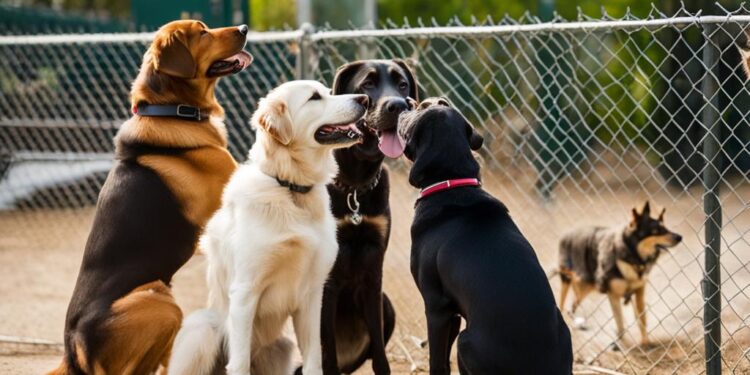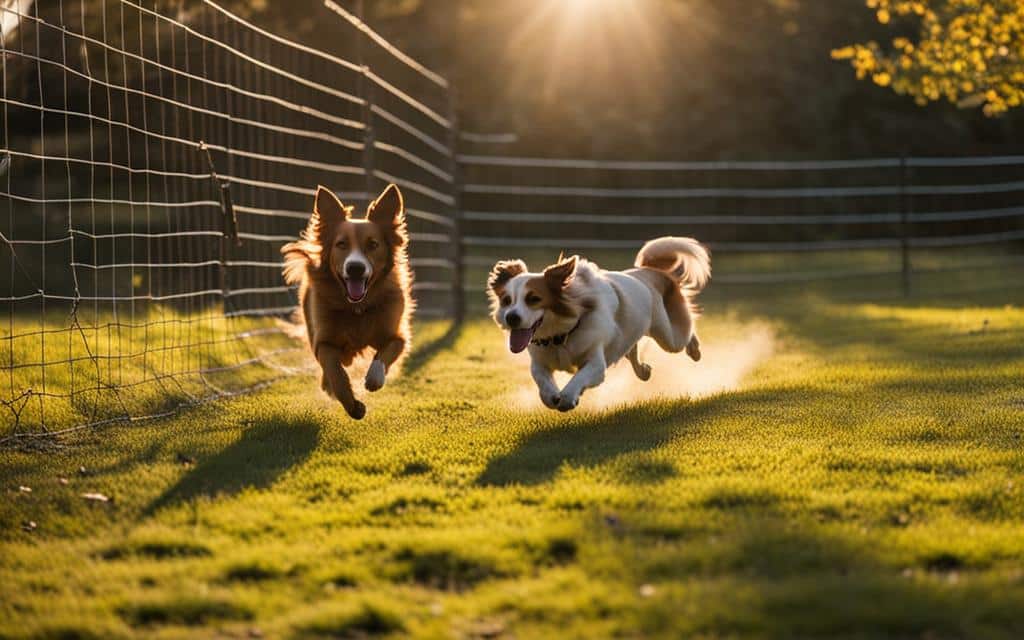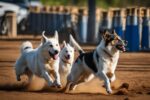Canine Courtesies: Navigating Dog Park Etiquette

Dog park etiquette is essential for ensuring a harmonious and enjoyable experience for both dogs and their owners. By following a few simple guidelines, you can create a positive environment for everyone at the dog park.
Knowing the rules and understanding socializing tips can make a significant difference in the park. From proper socializing to off-leash play, being aware of the do’s and don’ts can enhance your dog’s experience and overall park visit.
In this article, we will explore the importance of dog park etiquette and provide essential tips to navigate socializing and off-leash playtime. So, let’s dive in and discover how to make the most out of your dog park visits!
Proper Socializing Tips for Dogs in a Park Setting
Socializing is an important part of a dog’s development, and the dog park can provide an excellent opportunity for them to interact with other dogs. However, proper socialization is key to ensuring a positive and safe experience for everyone involved. Here are some tips to help you navigate canine socialization in a park setting:
1. Observe and Assess
Before introducing your dog to others at the park, take a moment to observe their behavior from a distance. Assess their body language and energy levels to gauge their readiness for socializing. Look for signs of relaxation and interest like loose body posture and wagging tails.
2. Gradual Introductions
When introducing your dog to new pups, start with one-on-one interactions rather than a large group. This allows them to establish a more personal connection and build trust. Keep the initial meeting short and positive, gradually extending the duration as they become more comfortable.
3. Positive Reinforcement
Use positive reinforcement techniques to encourage good behavior during social interactions. Reward your dog with treats and praise when they display friendly and appropriate behavior, such as gentle play and sharing toys. This helps reinforce positive associations with socializing and encourages desirable actions.
Remember, every dog is unique, and some may require more time and patience when it comes to socializing. Always prioritize your dog’s comfort and well-being, and never force interactions if they seem uncomfortable or overwhelmed. With these proper socializing tips, you can help your furry friend develop strong social skills and enjoy their time at the dog park.
Table: Common Dog Park Behaviors and Their Meanings
| Behavior | Meaning |
|---|---|
| Play Bow | A friendly invitation to play |
| Tail Wagging | Generally indicates happiness and friendliness, but it’s important to assess the overall body language |
| Growling | Can be a warning sign of discomfort or aggression; pay attention to other accompanying body language |
| Stiff Body | May indicate fear, anxiety, or tension; monitor the situation closely and provide support if needed |
| Jumping Up | Excitement or an attempt to establish dominance; redirect this behavior towards more appropriate greetings |
Off-Leash Play: Dos and Don’ts
Off-leash play is a great way for dogs to burn off energy and socialize with other dogs at the park. However, it’s crucial to follow proper etiquette to ensure a safe and enjoyable experience for everyone. Here are some important dos and don’ts to keep in mind:
Do:
- Ensure your dog is well-socialized and friendly towards other dogs before allowing them off-leash.
- Keep a close eye on your dog at all times to monitor their behavior and prevent any potential conflicts.
- Call your dog back to you promptly when it’s time to leave or if they’re becoming too rowdy.
- Be aware of your dog’s play style and match them with dogs who have a similar energy level and play style.
- Follow any posted park rules or guidelines regarding off-leash play.
Don’t:
- Allow your dog to approach or pester other dogs who are not interested in interacting.
- Bring toys or treats that could potentially cause resource guarding or conflicts with other dogs.
- Allow your dog to display aggressive behavior towards other dogs or humans.
- Leave your dog unattended or unsupervised during off-leash play.
- Overstay your welcome – be mindful of the time and make room for other dogs to enjoy the park as well.
Remember, off-leash play should be a positive and enjoyable experience for all dogs and owners. By following these dos and don’ts, you can help create a safe and harmonious environment at the off-leash dog park.
| Off-Leash Play Dos | Off-Leash Play Don’ts |
|---|---|
| Ensure your dog is well-socialized and friendly towards other dogs | Allow your dog to approach or pester other dogs who are not interested in interacting |
| Keep a close eye on your dog at all times | Bring toys or treats that could potentially cause resource guarding or conflicts |
| Call your dog back promptly when it’s time to leave or if they’re becoming too rowdy | Allow your dog to display aggressive behavior towards other dogs or humans |
| Be aware of your dog’s play style and match them with similar dogs | Leave your dog unattended or unsupervised during off-leash play |
| Follow any posted park rules or guidelines | Overstay your welcome – be mindful of the time |
Conclusion
Navigating dog park etiquette is crucial for fostering a positive and safe environment for dogs and their owners. By following the guidelines and tips mentioned above, you can ensure a harmonious and enjoyable experience for everyone involved.
Remember to always clean up after your dog, as this demonstrates respect for the park and other visitors. Proper waste disposal helps maintain a clean and hygienic space for everyone to enjoy.
Respecting other dogs’ space is also important. Give dogs and their owners ample room to play and avoid overcrowding. It’s essential to recognize when a dog may need space or not be interested in interacting, and to respect their boundaries accordingly.
Lastly, be mindful of proper socializing and off-leash play. Encourage positive interactions between dogs by allowing them to greet each other calmly and avoid intervening in their play unless necessary. Keeping an eye on your dog’s behavior ensures a safe and fun experience for all.
With a little consideration and adherence to dog park rules, you can create a fantastic playtime experience for your furry friend and build lasting connections with fellow dog lovers. Let’s all contribute to a dog park environment that promotes canine courtesies and harmonious playtime for everyone.
FAQ
Why is dog park etiquette important?
Dog park etiquette is important to ensure a harmonious and enjoyable experience for all dogs and their owners. It helps create a positive environment and promotes safe and respectful interactions.
How can I encourage proper socializing for my dog at the park?
To encourage proper socializing, introduce your dog to the park gradually, observe their body language, and allow them to interact at their own pace. Supervise their interactions, intervene if necessary, and reward positive behaviors.
What should I do if my dog becomes aggressive or overly excited during off-leash play?
If your dog becomes aggressive or overly excited, it’s important to immediately remove them from the situation and calm them down. Take a break, redirect their attention with toys or training exercises, and seek professional help if the behavior persists.
How can I ensure a safe and enjoyable off-leash play experience?
To ensure a safe and enjoyable off-leash play experience, always supervise your dog, respect other dogs’ space, and be mindful of their cues. Keep your dog’s vaccinations up to date, avoid bringing toys or treats that may cause conflicts, and clean up after your dog to maintain a clean environment.
What are some common dog park etiquette rules to remember?
Some common dog park etiquette rules to remember include cleaning up after your dog, keeping them leashed until entering designated off-leash areas, avoiding bringing aggressive or unvaccinated dogs, and respecting other owners and their dogs’ boundaries.







